spare tire BUICK CENTURY 1994 Owners Manual
[x] Cancel search | Manufacturer: BUICK, Model Year: 1994, Model line: CENTURY, Model: BUICK CENTURY 1994Pages: 308, PDF Size: 16.3 MB
Page 173 of 308
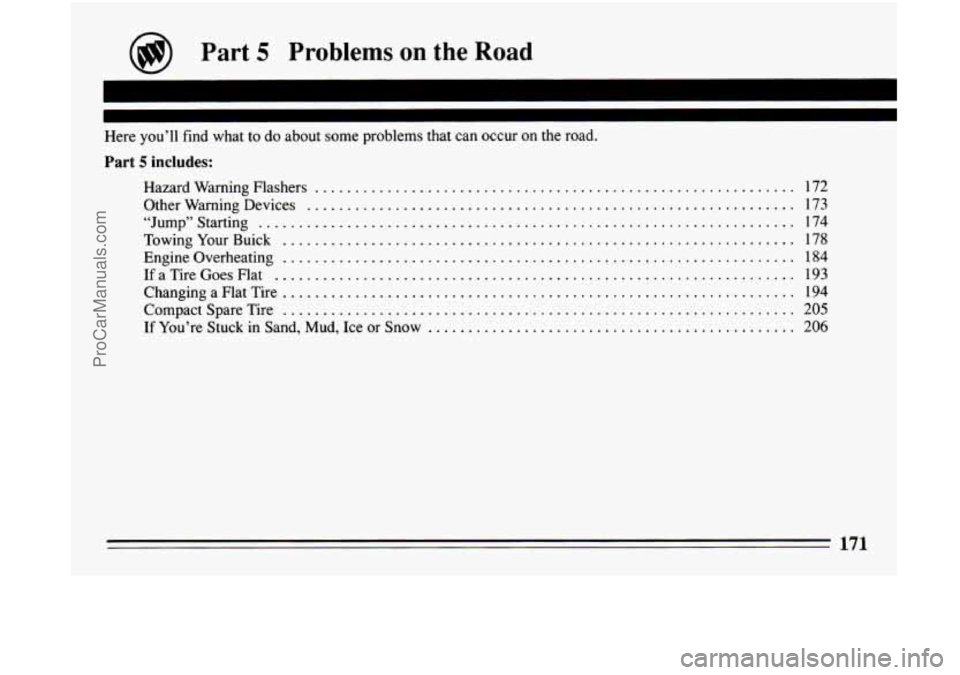
@) Part 5 Problems on the Road
I
I
Here you’ll find what to do about some problems that can occur on the road .
Part 5 includes:
HazardWarningFlashers ............................................................ 172
OtherWarningDevices
............................................................. 173
“Jump”Starting
................................................................... 174
TowingYourBuick
................................................................ 178
Engineoverheating
................................................................ 184
IfaTireGoesFlat
................................................................. 193
ChangingaFlatTire
................................................................ 194
CompactSpareTire
................................................................ 205
If You’re Stuck in Sand, Mud, Ice or Snow .............................................. 206
1 I1
ProCarManuals.com
Page 197 of 308
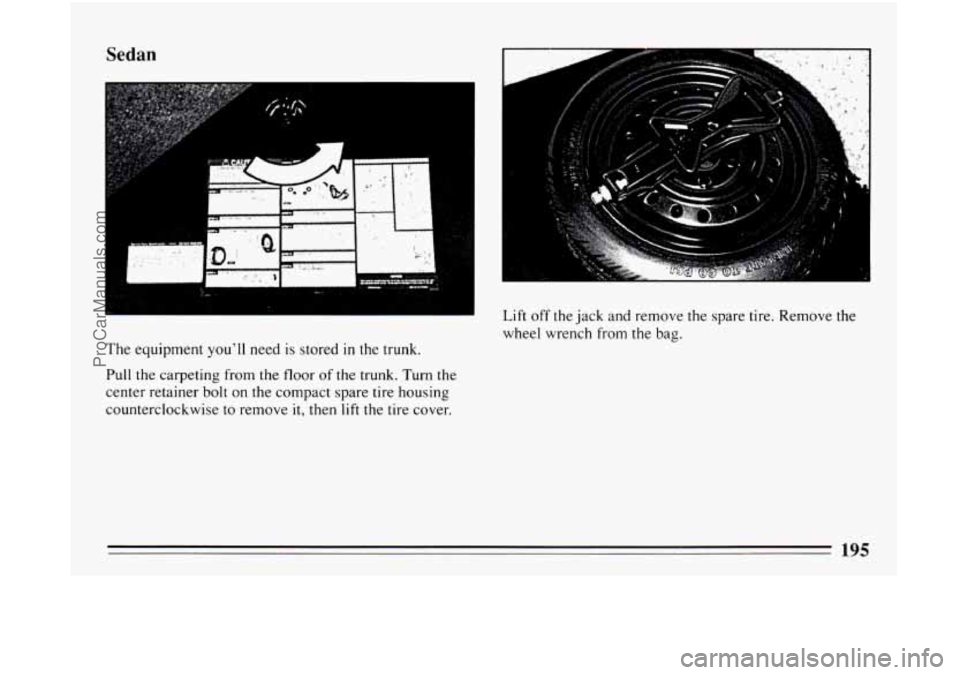
Sedan
The equipment you'll need is stored in the trunk.
Pull the carpeting from the floor of the trunk. Turn the
center retainer bolt on the compact spare tire housing
counterclockwise to remove
it, then lift the tire cover. Lift off
the jack and remove
the spare tire. Remove the
wheel wrench from the
bag.
195
ProCarManuals.com
Page 198 of 308
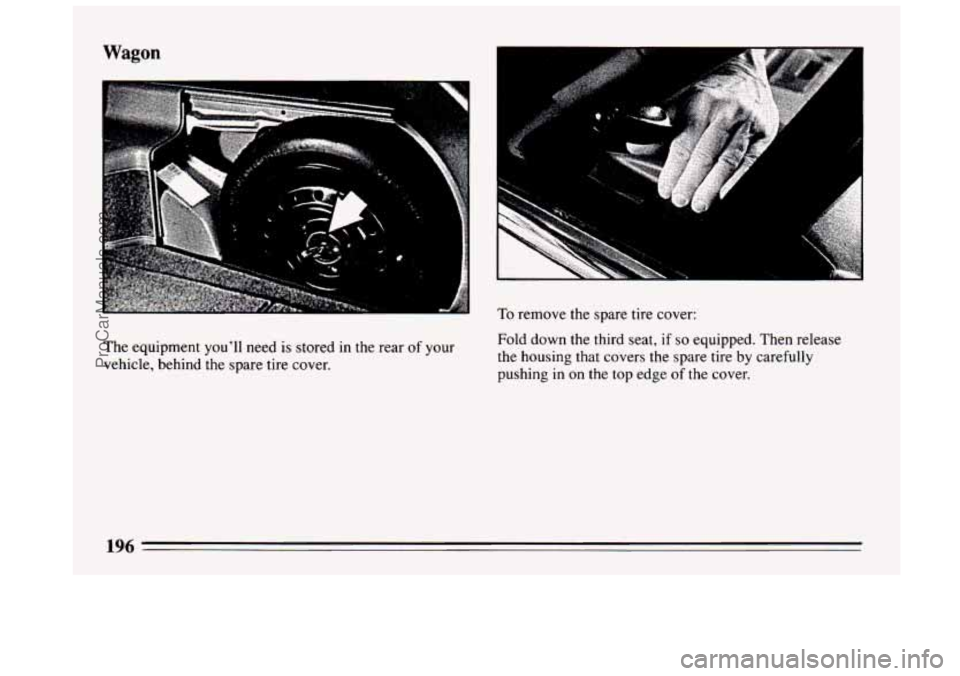
Wagon
The equipment you’ll need is stored in the rear of your
vehicle, behind the spare tire cover.
I
To remove the spare tire cover:
Fold
down the third seat, if so equipped. Then release
the housing that covers
the spare tire by carefully
pushing
in on the top edge of the cover.
196
ProCarManuals.com
Page 199 of 308
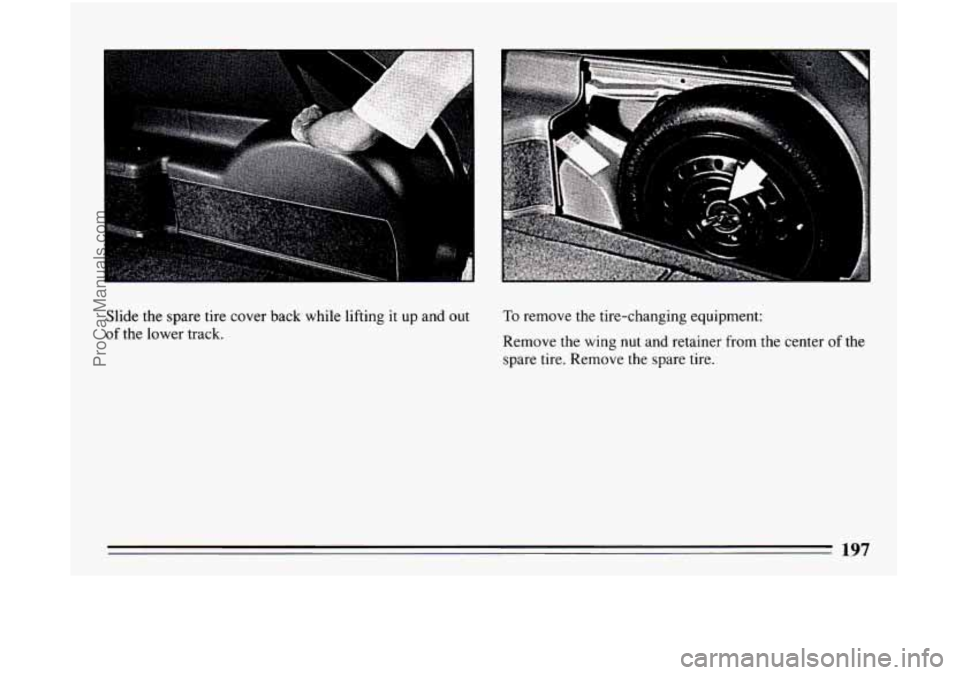
Slide the spare tire cover back while lifting it up and out
of the lower track.
To remove the tire-changing equipment:
Remove the wing
nut and retainer from the center of the
spare tire. Remove the spare tire.
197
ProCarManuals.com
Page 202 of 308
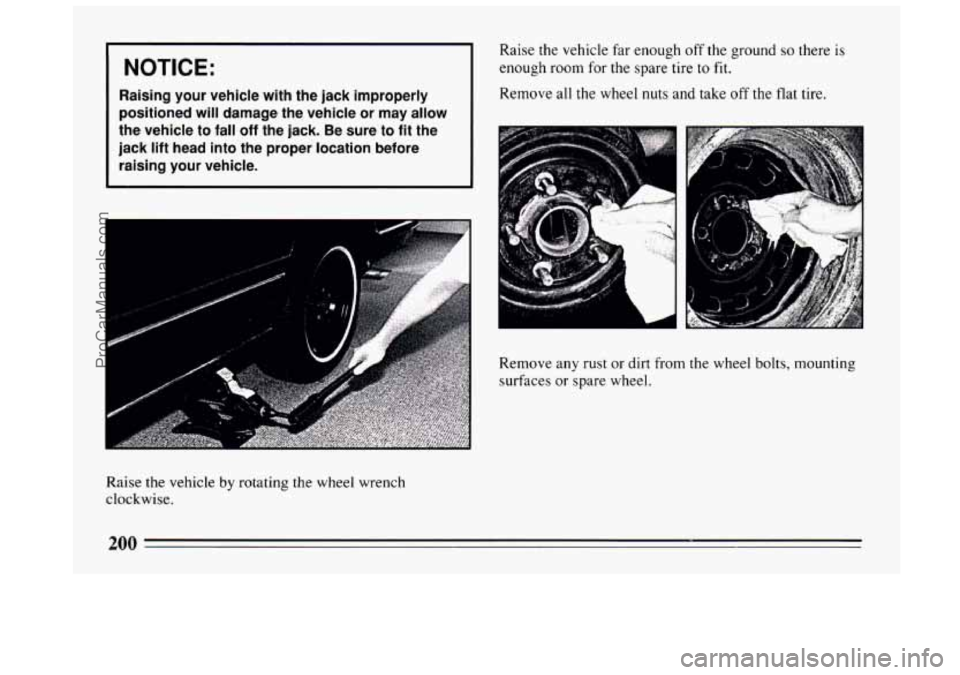
I NOTICE:
Raising your vehicle with the jack improperly
positioned will damage the vehicle or may
allow
the vehicle to fall off the jack. Be sure to fit the
jack lift head into the proper location before raising your vehicle.
Raise the vehicle by rotating the wheel wrench
clockwise. Raise the vehicle far enough
off the ground
so there is
enough room for the spare tire to fit.
Remove all the wheel nuts and take
off the flat tire.
Remove any rust or dirt from
the wheel bolts, mounting
surfaces or spare wheel.
200
ProCarManuals.com
Page 205 of 308

Don’t try to put a wheel cover on your compact spare
tire. It won’t fit. Store the wheel cover in the trunk or, if
you have the wagon, in the rear cargo area, until you
have the flat tire repaired or replaced.
I NOTICE:
Wheel covers won’t fit on your compact spare.
If you try to put a wheel cover on your compact
spare, you could damage the cover or the spare.
Now put all the equipment back in the vehicle.
Sedan
BOLT
203
ProCarManuals.com
Page 206 of 308

UT WHEEL
WRENCH
FULL SIZE FLAT /
JACK
USE TOP HOLE WITH VALVE STEM OUTBOARD FOR STORAGE OF
FULL-SIZE FLAT
Wagon Spare Cover Replacement
To install the spare tire cover in your station wagon
when
you are finished changing the tire:
1.
2.
3.
4.
Wagon 5.
Put the front lower corner of the cover into the floor
track. Overlap the lower rear edge of the front panel
one to two inches.
Slide the cover to the front;. the tabs must go
under
the rear edge.
Insert the front upper corner into the track, at the
bottom of the glass.
Adjust the position
of the cover to fit over the
weatherstrip. Push the panel down into the track in
the floor.
Push the panel to lock it into the track
of the molding
at
the bottom of the glass.
204
ProCarManuals.com
Page 207 of 308
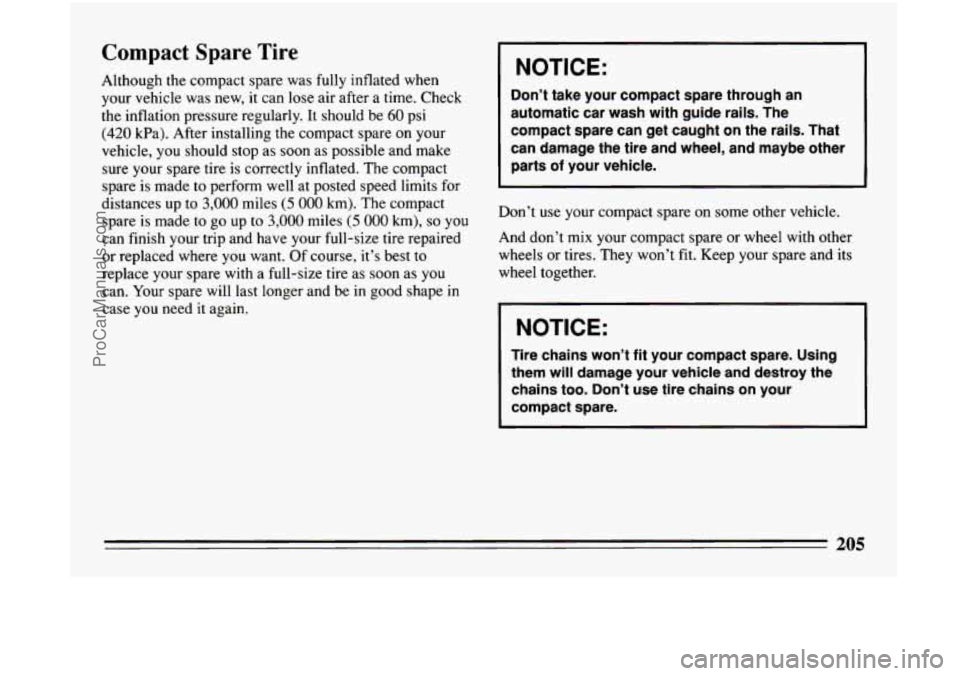
Compact Spare Tire
Although the compact spare was fully inflated when
your vehicle was new, it can lose air after a time. Check
the inflation pressure regularly. It should be 60 psi
(420 kPa). After installing the compact spare on your
vehicle, you should stop as soon as possible and make
sure your spare tire is correctly inflated. The compact
spare is made to perform well at posted speed limits for
distances up to
3,000 miles (5 000 km). The compact
spare is made to go up to
3,000 miles (5 000 km), so you
can finish your trip and have your full-size tire repaired
or replaced where you want. Of course, it’s best to
replace your spare
with a full-size tire as soon as you
can. Your spare will last longer and be in good shape
in
case you need it again.
I NOTICE:
Don’t take your compact spare through an
automatic car wash with guide rails. The
compact spare can get caught on the rails. That
can damage the tire and wheel, and maybe other
parts of your vehicle.
Don’t use your compact spare on some other vehicle.
And don’t
mix your compact spare or wheel with other
wheels or tires. They won’t fit. Keep your spare and its
wheel together.
NOTICE:
Tire chains won’t fit yoUP-Cijimpct spare. Using
them will damage your vehicle and destroy the
chains too. Don’t use tire chains
on your
compact spare.
205
ProCarManuals.com
Page 240 of 308
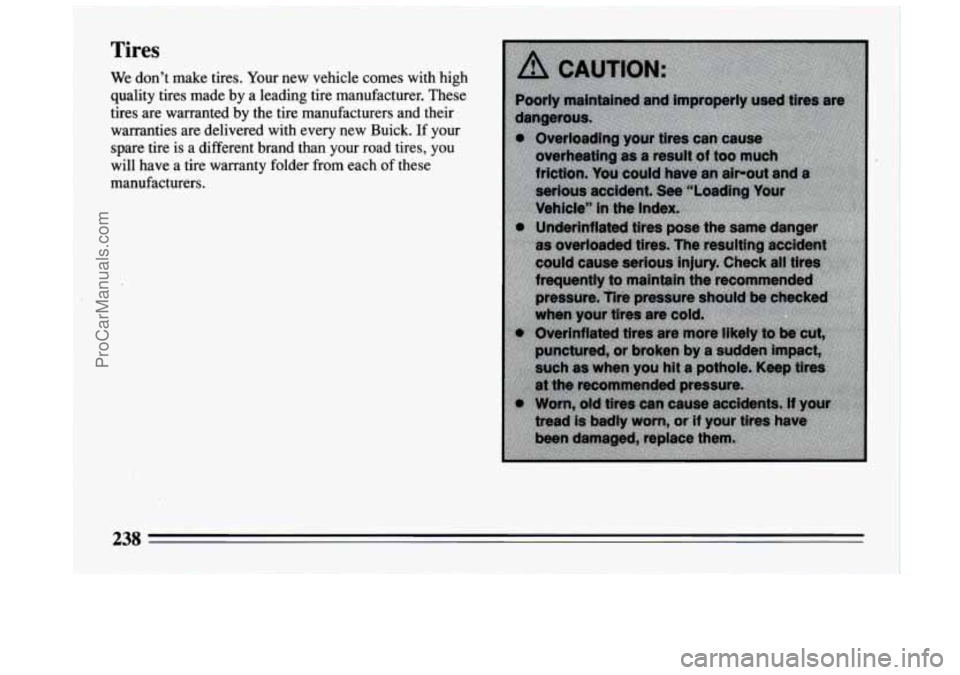
Tires
We don't make tires. Your new vehicle comes with high
quality tires made by a leading tire manufacturer. These
tires are'warranted by the tire manufacturers and their
warranties are delivered with every new Buick. If your
spare tire is a different brand than your road tires, you
will have
a tire warranty folder from each of these
manufacturers.
238
ProCarManuals.com
Page 241 of 308
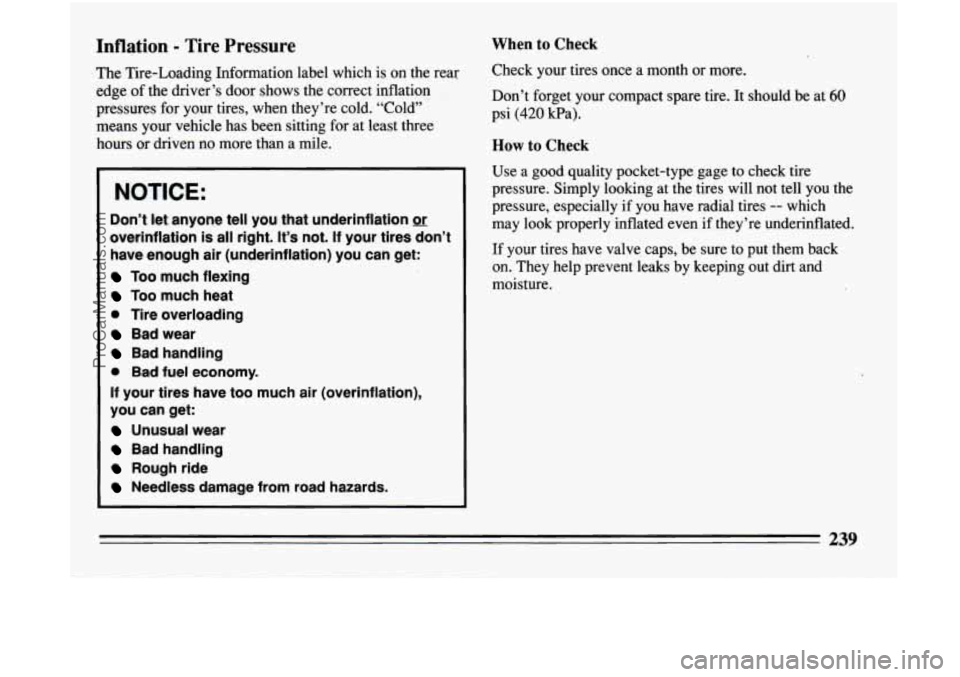
Inflation - Tire Pressure
The Tire-Loading Information label which is on the rear
edge of the driver’s door shows the correct inflation
pressures for your tires, when they’re cold. “Cold”
means your vehicle has been sitting for at least three
hours or driven no more than a mile.
I NOTICE:
Don’t let anyone tell you that underinflation 911
overinflation is all right. It’s not. If your tires don’t
have enough air (underinflation) you can get:
Too much flexing
Too much heat
0 Tire overloading
Bad wear
Bad handling
0 Bad fuel economy.
If your tires have too much air (overinflation),
you can get:
Unusual wear
Bad handling
Rough ride
Needless damage from road hazards.
When to Check
Check your tires once a month or more.
Don’t forget your compact spare tire. It should be at
60
psi (420 kPa).
How to Check
Use a good quality pocket-type gage to check tire
pressure. Simply looking at the tires will not tell you the
pressure, especially if you have radial tires
-- which
may look properly inflated even if they’re underinflated.
If your tires have valve caps, be sure to put them back
on. They help prevent leaks by keeping out dirt and
moisture.
239
ProCarManuals.com